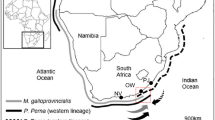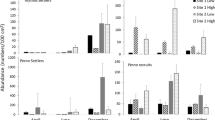Abstract
Many South African populations of the brown mussel Perna perna have been depleted through over-exploitation by subsistence harvesters. This is problematic because recovery after disturbance is very slow, partly because recruits are largely associated with adult mussels. However, unlike large recruits of 3.5–10 mm that exhibit spatial structure related to that of adults, a very high proportion of settlers and small recruits (0–3.5 mm) occur on foliose algae. We tested the hypothesis that recruits on algae move to adult mussel beds after a period of growth, with the null hypothesis that they die at a certain size. We conducted an indirect field study comparing the ratios of large to small recruits in 100% cover mussel patches at locations with high and low algal cover. A second laboratory experiment analysed whether the size of recruits on algae affects their active movement behaviour in response to nearby mussel patches. Large/small recruit ratios were slightly, but not significantly greater in high than low algal cover locations. Both small (2–2.5 mm) and medium (4.5–5.5 mm) recruits remained on algae and moved very short distances throughout the laboratory experiment, while larger recruits (9–10 mm) moved significantly further distances and more often into mussel patches. The results suggest that very large recruits are able to migrate actively to nearby mussel patches, indicating ontogenetic shifts in this behaviour. However, the absence of a significant difference in ratios between field locations with high and low algal cover suggests many large recruits are accidentally dislodged from the algae and presumably die. Thus settlement of P. perna onto algae is likely to be wasted, with consequences for sustainable management of the mussel resource.




Similar content being viewed by others
References
Alvarado JL, Castilla JC (1996) Tridimensional matrices of mussels Perumytilus purpuratus on intertidal platforms with varying wave forces in central Chile. Mar Ecol Prog Ser 133:135–141
Baker P, Mann R (1997) The postlarval phase of bivalve mollusks: a review of functional ecology and new records of postlarval drifting of Chesapeake Bay bivalves. Bull Mar Sci 61(2):409–430
Bayne BL (1964) Primary and secondary settlement in Mytilus edulis L. (Mollusca). J Anim Ecol 33:513–523
Beckley LE (1979) Primary settlement of Perna perna (L.) on littoral seaweeds on St. Croix Island. S Afr J Zool 14:171
Booth DJ, Brosnan DM (1995) The role of recruitment dynamics in rocky shore and coral reef fish communities. Adv Ecol Res 26:309–385
Bourget E, Harvey M (1998) Spatial analysis of recruitment of marine invertebrates on arborescent substrata. Biofouling 12:45–55
Branch GM, Griffiths CL, Branch ML, Beckley LE (1994) Two oceans: a guide to the marine life of southern Africa. David Philip Publishers, Cape Town
Bruno JF, Stachowicz JJ, Bertness MD (2003) Inclusion of facilitation into ecological theory. Trends Ecol Evol 18(3):119–125
Buchanan S, Babcock R (1997) Primary and secondary settlement by the Greenshell mussel Perna canaliculus. J Shellfish Res 16(1):71–76
Caceres-Martinez J, Robledo JAF, Figueras A (1994) Settlement and post-larvae behaviour of Mytilus galloprovincialis—field and laboratory experiments. Mar Ecol Prog Ser 112(1–2):107–117
Caley MJ, Carr MH, Hixon MA, Hughes TP, Jones GP, Menge BA (1996) Recruitment and the local dynamics of open marine populations. Annu Rev Ecol Syst 27:477–500
Castilla JC (1999) Coastal marine communities: trends and perspectives from human-exclusion experiments. Trends Ecol Evol 14(7):280–283
Commito JA, Rusignuolo BR (2000) Structural complexity in mussel beds: the fractal geometry of surface topography. J Exp Mar Biol Ecol 255:133–152
de Montaudouin X (1997) Potential of bivalves’ secondary settlement differs with species: a comparison between cockle (Cerastoderma edule) and clam (Ruditapes philippinarum) juvenile resuspension. Mar Biol 128:639–648
de Montaudouin X, Bachelet G, Sauriau P-G (2003) Secondary settlement of cockles Cerastoderma edule as a function of current velocity and substratum: a flume study with benthic juveniles. Hydrobiologia 503:103–116
de Vooys CGN (2003) Effect of a tripeptide on the aggregational behaviour of the blue mussel Mytilus edulis. Mar Biol 142:1119–1123
Dolmer P, Frandsen RP (2002) Evaluation of the Danish mussel fishery: suggestions for an ecosystem management approach. Helgol Mar Res 56:13–20
Dye AH, Dyantyi N (2002) Reseeding of mussels on denuded rocky shores: preliminary studies with the brown mussel Perna perna. S Afr J Mar Sci 24:65–70
Erlandsson J, McQuaid CD (2004) Spatial structure of recruitment in the mussel Perna perna at local scales: effects of adults, algae and recruit size. Mar Ecol Prog Ser 267:173–185
Erlandsson J, McQuaid CD, Kostylev VE (2005) Contrasting spatial heterogeneity of sessile organisms within mussel (Perna perna) beds in relation to topographic variability. J Exp Mar Biol Ecol 314:79–97
Erlandsson J, Pal P, McQuaid CD (2006) Re-colonisation rate differs between co-existing indigenous and invasive intertidal mussels following major disturbance. Mar Ecol Prog Ser 320:169–176
Folino-Rorem N, Stoeckel J, Thorn E, Page L (2006) Effects of artificial filamentous substrate on zebra mussel (Dreissena polymorpha) settlement. Biol Invasions 8:89–96
Hammond W, Griffiths C (2006) Biogeographical patterns in the fauna associated with southern African mussel beds. Afr Zool 41(1):123–130
Harris JM, Branch GM, Elliott BL, Currie B, Dye A, McQuaid CD, Tomalin BJ, Velasquez C (1998) Spatial and temporal variability in recruitment of intertidal mussels around the coast of southern Africa. S Afr J Zool 33:1–11
Hunt HL, Scheibling RE (1998) Spatial and temporal variability of patterns of colonization by mussels (Mytilus trossulus, M. edulis) on a wave-exposed rocky shore. Mar Ecol Prog Ser 167:155–169
Hunt HL, Scheibling RE (2002) Movement and wave dislodgment of mussels on a wave-exposed rocky shore. Veliger 45(4):273–277
Kautsky N, Evans S (1987) Role of biodeposition by Mytilus edulis in the circulation of matter and nutrients in a Baltic coastal ecosystem. Mar Ecol Prog Ser 38:201–212
Kostylev V (1996) Spatial heterogeneity and habitat complexity affecting marine littoral fauna. PhD thesis, Göteborg University, Göteborg, Sweden
Kostylev V, Erlandsson J, Johannesson K (1997) Microdistribution of the polymorphic snail Littorina saxatilis (Olivi) in a patchy rocky shore habitat. Ophelia 47:1–12
Kyle R, Pearson B, Fielding PJ, Robertson WD, Birnie SL (1997) Subsistence shellfish harvesting in the Maputaland Marine Reserve in northern KwaZulu-Natal, South Africa: Rocky shore organisms. Biol Conserv 82(2):183–192
Lasiak TA, Barnard TCE (1995) Recruitment of the brown mussel Perna perna onto natural substrata: a refutation of the primary/secondary settlement hypothesis. Mar Ecol Prog Ser 120:147–153
Lasiak T, Dye A (1989) The ecology of the brown mussel Perna perna in Transkei, Southern Africa: implications for the management of a traditional food resource. Biol Conserv 47(4):245–257
Lasiak TA, Field JG (1995) Community-level attributes of exploited and non-exploited rocky infratidal macrofaunal assemblages in Transkei. J Exp Mar Biol Ecol 185:33–53
Lawrie SM, McQuaid CD (2001) Scales of mussel bed complexity: structure, associated biota and recruitment. J Exp Mar Biol Ecol 257:135–161
McGrath D, King PA, Gosling EM (1988) Evidence for the direct settlement of Mytilus edulis larvae on adult mussel beds. Mar Ecol Prog Ser 47:103–106
McQuaid CD, Lindsay JR, Lindsay TL (2000) Interactive effects of wave exposure and tidal height on population structure of the mussel Perna perna. Mar Biol 137:925–932
McQuaid CD, Lindsay JR (2005) Interacting effects of wave exposure, tidal height and substratum on spatial variation in densities of mussel Perna perna plantigrades. Mar Ecol Prog Ser 301:173–184
McQuaid CD, Phillips TE (2006) Mesoscale variation in reproduction, recruitment and population structure of intertidal mussels with low larval input: a bay/open coast comparison. Mar Ecol Prog Ser 327:193–206
Munch-Petersen S, Kristensen PS (2001) On the dynamics of the stocks of blue mussels (Mytilus edulis L.) in the Danish Wadden Sea. Hydrobiologia 465:31–43
Norse EA, Crowder LB (eds) (2005) Marine conservation biology. Island Press, Washington
Okamura B (1986) Group living and the effects of spatial position in aggregations of Mytilus edulis. Oecologia 69:341–347
Paine RT, Levin SA (1981) Intertidal landscapes: disturbance and the dynamics of pattern. Ecol Monogr 51(2):145–178
Pettersson P (2006) Role of Mytilus for biodiversity in sediment habitats of the Skagerrak and Baltic Sea. Licentiate in Philosophy thesis in marine ecotoxicology, Stockholm University, Sweden
Porri F, McQuaid CD, Radloff S (2006a) Temporal scales of variation in settlement and recruitment of the mussel Perna perna (Linnaeus, 1758). J Exp Mar Biol Ecol 332:178–187
Porri F, McQuaid CD, Radloff S (2006b) Spatio-temporal variability of larval abundance and settlement of Perna perna: differential delivery of mussels. Mar Ecol Prog Ser 315:141–150
Quinn GP, Keough MJ (2002) Experimental design and data analysis for biologists. Cambridge University Press, Cambridge
Rius M, Kaehler S, McQuaid CD (2006) The relationship between human exploitation pressure and condition of mussel populations along the south coast of South Africa. S Afr J Sci 102:130–136
Seed R (1969) The ecology of Mytilus edulis L. (Lamellibranchiata) on exposed rocky shores: I. Breeding and settlement. Oecologia 3:277–316
Suchanek TH (1985) Mussels and their rôle in structuring rocky shore communities. In: Moore PG, Seed R (eds) The ecology of rocky coasts. Columbia University Press, New York, pp 70–96
Tomalin BJ, Kyle R (1998) Subsistence and recreational mussel (Perna perna) collecting in KwaZulu-Natal, South Africa: fishing mortality and precautionary management. S Afr J Zool 33(1):12–22
Underwood AJ (1997) Experiments in ecology: their logical design and interpretation using analysis of variance. Cambridge University Press, Cambridge
Acknowledgments
We thank two anonymous reviewers for improving the manuscript, and M. Sköld for ideas related to the testing of one hypothesis. This study was funded jointly by Formas (The Swedish Research Council for Environment, Agricultural Sciences and Spatial Planning) and Sida/Sarec in Sweden to JE, and by MCM (Marine & Coastal Management) and Claude Leon Foundation to FP. The present study complies with the current laws of South Africa.
Author information
Authors and Affiliations
Corresponding author
Additional information
Communicated by M. Kühl.
Rights and permissions
About this article
Cite this article
Erlandsson, J., Porri, F. & McQuaid, C.D. Ontogenetic changes in small-scale movement by recruits of an exploited mussel: implications for the fate of larvae settling on algae. Mar Biol 153, 365–373 (2008). https://doi.org/10.1007/s00227-007-0812-z
Received:
Accepted:
Published:
Issue Date:
DOI: https://doi.org/10.1007/s00227-007-0812-z




